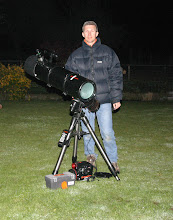It is, for this region, again a very clear night with NELM probably better than 5,5. Also the seeing is excellent tonight. The aim of today is to do the 2 open clusters of HII in Vulpecula, combined with the showpieces.
Date May 29, 2009
Location: Boutersem
Equipment: Obsession 18”
Eyepieces: 24mm; 16mm, Powermate 2,5x
Nelm: 5.5
Seeing: excellent.
Time 23:30Hr UT to 01Hr00UT. Clouds appearing at 0:00.
NGC 6793 – open cluster in Vul
Observed at 124x and 211x. NGC 6793 is a loose cluster of 10 bright stars in an area of 10’. 2 distinct groups are visible with each a triangle made up of 3 bright stars. The most northern star of the northern triangle is a double star.
NGC 6800 – open cluster in Vul
Observed at 124x. This cluster does not stand out well from its surroundings. There is a light concentration of stars in an area of 15’. A ring of 10 bright stars and 20 faint stars are forming the edge of his cluster. An obvious “void” at the centre of this object.
After those 2 HII objects I spend the remaining of the time observing showpieces in the typical summer constellation.
First in Scorpio because it’s culminating. M80 and M4 are splendid globulars.
In Ophiuchus I looked for M10, M12 and M14. Next time I’ll prepare a list with some other objects in this large constellation.
Observing with an 18” in Cygnus is a wonderful experience. I’ve had amazing views of the Veil Nebula. Lot’s of details and structure were visible on both segments. Pickering triangle was easy to see.
Also the Crescent nebula provided awesome views with details and structure.
NGC 7008 is one of my favorite planetaries in Cygnus. The 2 nodules give it an irregular shape. Brightness is irregular. Two stars are superimposed on the object.
Another nice planetary is NGC 7048. It’s a grey disc which is slightly elongated. Did not see the superimposed star.
The next planetary is NGC 6894, which is also a terrific object to observe. It’s a grey ring with a darker centre. The northern edge is slightly brighter.
The blinking planetary (NGC 6826) is chooses to end this beautiful observation session. This planetary is nicer to observe without filter. The central star is obvious. The blinking effect is always a nice effect to look at. Interestingly, the nebula did not fade completely away, while it did with my 20cm scope (as far as I remember though).
Subscribe to:
Post Comments (Atom)
+v2.jpg)
1 comment:
Your telescope is amazing... I really want to know about our sky Universe. It would be good If you post some images that u see via your telescope..
Post a Comment